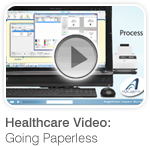The American Recovery and Reinvestment Act (ARRA) of 2009 is an economic stimulus package that plans to invest $59 billion in healthcare initiatives, including $19 billion in health information technology. ARRA has three main goals: to create new jobs, spur economic activity and create accountability and transparency in government spending.
CCHIT stands for the Certification Commission for Health Information Technology. It is a non-governmental certification body for EHRs. Currently, CCHIT certified EHRs have not been certified by the federal government for incentive eligibility. CCHIT will be one of multiple avenues to HITECH stimulus incentives.
CMS, or the Centers for Medicare and Medicaid Services is a federal agency that administers and regulates Medicare and works in conjunction with state governments to administer Medicaid and other state controlled insurance programs.
CPT Codes, or Current Procedural Terminology codes, describe medical, surgical and diagnostic procedures. The American Medical Association publishes this code to communicate uniform information to physicians, diagnostic technicians and insurance payers.
EHR
EHR, or electronic health record, is an interoperable system that provides for the capture of data from multiple sources and is used as the primary source of information to support clinical decision making at the point of care. .
EMR
EMR, or electronic medical record, is a term that is often used in physician practices to refer to systems that replace paper charts but often do not include clinical decision support or interoperability. In hospitals, EMR often refers to a document imaging system.
E-Prescribing, or electronic prescribing, is a system that supports the creation and transmission of complete, accurate, and legible prescriptions and associated transactions (e.g. refill requests and approvals) between a provider and a retail pharmacy.
HHS stands for the US Department of Health and Human services which is the federal agency that directs and manages the ONCHIT as well as the Centers for Medicare and Medicaid Services.
HIT
HIT, or health information technology (HIT) refers to the use of information technology in the management and dissemination of health information from patients to providers and insurers. HIT is commonly viewed as the most promising manner of improving care, reducing costs and reforming healthcare delivery.
HITECH Act
The Health Information Technology for Economic and Clinical Health Act (HITECH Act) is the piece of legislation in the ARRA that designates $19 billion to providers and hospitals who demonstrate ‘meaningful use’ of electronic health records.
HITECH Incentive
Of the $19 billion provisioned by the HITECH Act, each provider who demonstrates ‘meaningful use’of an EHR system is eligible for up to $44,000 in Medicare bonus incentives and up to $65,000 in Medicaid bonus incentives. HITECH payments will be made over a five year period from 2011 to 2015.
HIPAA, or The Health Insurance Portability and Accountability Act of 1996, is the law passed by Congress to provide continuous insurance coverage and reduce insurance fraud and abuse. The Administrative Simplification section requires adoption of standards for claims and other financial and administrative transactions, code sets, identifiers, privacy, and security.
HL7, or Health Level Seven, is an organization created in the 1980s to develop standard protocols to aid in exchanging data among disparate health information technology systems.
ICD Codes classify diseases or signs, symptoms, abnormal findings, complaints, social circumstances and external causes of injury or disease. ICD is short for the International Statistical Classification of Diseases and Related Health Problems. ICD codes are published by the World Health Organization and are used worldwide for insurance reimbursement and statistics. The code edition being used currently is ICD-9. However ICD-11 codes are expected to be released within the next year.
Meaningful Use is set of standards for determining eligibility for Medicare and Medicaid incentive payments. The specifics of the meaningful use standards are being published in the summer of 2010.
Medicaid Incentive Payment Program
A set of rules outlining the method of qualifying and calculating Medicaid Incentives
Medicare Incentive Payment Program
A set of rules outlining the method of qualifying and calculating Medicare Incentives
National Committee on Vital and Health Statistics
The public advisory committee to the Department of Health and Human Services for national health information infrastructure.
The Office of the National Coordinator for Health Information and Technology (ONCHIT) is the body charged with the organization and implementation of health information technology under HITECH. ONCHIT is also responsible for defining ‘meaningful use’ as it pertains to Medicare and Medicaid incentives.
Practice Management
Practice Management is a term that is commonly used to refer to the billing process. A practice management software program generally has a scheduler, a document upload section, a patient account information page and the ability to send and follow up on insurance claims.
Calculate your government reimbursements based on the number of Medicare or Medicaid patients your practice sees.
Secure Messaging
Secure Messaging is an integral feature of an EHR that allows healthcare professionals to send messages containing or referring to sensitive medical information. Traditional email is not considered secure enough to send or receive medical information under HIPAA.
SNOMED CT
SNOMED CT, or Systematized Nomenclature of Medicine-Clinical Terms, is a comprehensive clinical vocabulary developed by the College of American Pathologists and now maintained by the International Health Terminology Standards Development Organization in Denmark. It is now freely distributed in the United States under special licese from the U.S. National Library of Medicine. It is used in many EMR systems to encode clinical terms for use in clinical decision support systems.
A Superbill is a visit summary statement meant to be submitted to an insurance payer for reimbursement. A Superbill contains demographic and visit specific information such as name, date of service, ICD-9 codes, CPT codes and provider information.
Templates
Templates are a set of potential chart note comments organized around a chief complaint. An easily accessible set of comments is designed to facilitate the charting process while the provider is in front of patients. Templates are meant to be used in tandem with free form text entry necessary for a provider to capture the nuances of a particular visit.


